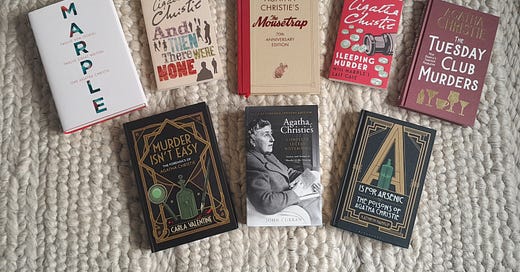Like many people, I first encountered the work of Agatha Christie on the small screen rather than on paper. I remember being mesmerised by David Suchet as Hercule Poirot, and intrigued by the changing face of Miss Marple as she was successively played by Joan Hickson, Geraldine McEwen and Julia Mackenzie.
I was in my twenties when I actually picked up one of Christie’s books. I was hooked from the first page and now I’ve read every story. Like all Christie’s readers, I have my favourites; the books I return to again and again.
These are the very same books that inspired me to write my own mysteries. I’ll talk more about the lessons all writers can take from Christie in a later blog, but for now I’ll focus on the lady herself and the joy that can be found from surrounding yourself with her work.
Who is Agatha Christie?
Agatha Miller was born in Torquay, Devon on 15 September 1890 and died at Winterbrook House, Oxfordshire on 12 January 1976, at the grand age of 85. Over those years, she lived through six British monarchs and two World Wars. She was married twice: first to Archie Christie, with whom she had her daughter Rosalind; and later to Max Mallowan, an archaeologist who Agatha accompanied around the world.
Agatha’s life was notable for many reasons, not least the 66 detective novels, 14 short story collections and 23 plays that she wrote. Indeed, she only started writing — the story would become her first published novel The Mysterious Affair at Styles — because her sister, Madge, bet her that she couldn’t do it. She was also one of the first British women to learn to surf (at the age of 32) and was an expert in poisons, a skill she gained while working at a hospital pharmacy during WWI. Evidence of this regularly appears through her novels.
What most people remember about Agatha is that she went missing for 11 days in December 1926. She was eventually found staying in the Swan Hotel in Harrogate (now home of the Theakston Old Peculiar Crime Writing Festival every July) where she had checked in as Theresa Neele, the name of her husband’s mistress. While the press turned against her at the time, suggesting the whole event was a publicity stunt, her disappearance is now largely set aside, a rightful footnote at the bottom of what was an illustrious career.
My favourite Christie works
I’m often asked which Agatha Christie story is my favourite. Like many readers, I find it hard to pick just one, so I’ve chosen my top three for this blog.
Some of my Agatha Christie collection, including The Mousetrap script, the 2022 compendium of new Miss Marple stories, and two non-fiction guides to poisons and forensics that are must-reads for crime/thriller authors.
My favourite stand-alone novel is And Then There Were None. Written in 1939, this novel was voted World’s Favourite Christie in 2015. It’s also the best-selling crime novel of all time — easy to see why when it has a magnificent ensemble cast and a delicious locked-room setting. I’ve read ATTWN many times, and each time I seem to find some little detail that I hadn’t noticed before; either a clue or a red herring. It’s a book that just keeps giving, but I also love the TV adaptation (BBC 2015) and was lucky enough to see the the play of the novel (written by Agatha in 1943) on stage last October. Quite frankly, if I could only ever read one Christie novel for the rest of time, it’s this one.
My favourite series novel is Sleeping Murder. Written during WWII when Agatha was living in London, this was one of two manuscripts (the other was Curtain: Poirot’s Last Case) that Christie held back to be published after her death. Originally titled Murder In Retrospect, this is also known as Miss Marple’s Last Case. Perhaps unsurprising then, that the story follows a young woman returning to Devon only to buy the same home she had lived in as a child, a house where a ‘perfect’ crime had been committed. SM is very different to many of Christie’s stories, with a sense of nostalgia and depth of feeling that can be missing in some of her other work. For me, it’s a hidden gem, a story that is well loved by Christie fans, but otherwise a little more unknown. I think that’s a bit of a shame, because it really is excellent.
My favourite play has to be The Mousetrap. Written in 1947 as a radio play titled Three Blind Mice, it was rewritten as The Mousetrap and premiered at Nottingham’s Theatre Royal in October 1952. It toured a number of English theatres before settling for a two-year stint at the Ambassador’s Theatre, London. And in March 1974, the play moved to St Martin’s Theatre, London, where it has been ever since. Having recently celebrated it’s 70th anniversary, The Mousetrap holds the record for the longest running show, of any kind, in the world. Another locked-room mystery with an ensemble cast, I’ve now seen it three times in three theatres on three tours, and each time I’ve absolutely loved it. If you haven’t seen The Mousetrap in person, I highly recommend you do.
The Mousetrap cast that appeared at the Cheltenham Everyman Theatre in 2023. Photograph by Matt Crockett
The enduring appeal
Christie’s appeal hasn’t dwindled in the almost fifty years after her death. Book sales remain high and the Christie family have worked hard to broaden her appeal to new audiences across the globe. As well as authorising biographies and other works of non-fiction, many of her stories have been adapted for stage and screen. In fact, just in the last year, there’s been a film, a two-part TV series and a new Poirot novel.
The film adaptation of Hallowe’en Party, re-titled A Haunting in Venice, was released in the cinema in September 2023, then added to various streaming services in December. This isn’t so much an adaptation as an almost complete retelling and, for me, it’s best viewed as a separate entity. While the cast is largely good, it travels too far from the original story and some characters (Ariadne Oliver in particular) are no longer believable. I found the film a little disappointing, especially when comparing it to the previous Branagh adaptations of Murder On The Orient Express and Death On The Nile.
In October 2023, Hercule Poirot’s Silent Night — the fifth new Hercule Poirot mystery, commissioned by the Christie family and written by Sophie Hannah — was published. Ably assisted by Inspector Catchpool, Poirot is called to a coastal mansion just before Christmas 1931 in order to solve a baffling mystery. Personally, I love having new Poirot novels, and even though the feel of the books is somewhat different to those written by Agatha herself, Sophie does a fantastic job at recreating the often pompous Belgian detective using her own plots and settings. I’ve read all five and will happily pick up the next one when it’s out.
The TV adaptation of Murder is Easy was broadcast on the BBC in December 2023, starring Penelope Wilton as Miss Pinkerton and David Jonsson as Luke Fitzwilliam. While there are departures from the novel — Fitzwilliam is a Nigerian attaché, allowing for a new subplot exploring colonisation, racism and torn loyalties — I found it hugely enjoyable: an excellent cast and beautiful production. If you haven’t seen it, it’s still available on iPlayer.
If Agatha Christie’s presence in mainstream media in the last twelve months tells me anything, it’s that her popularity continues to grow. I, for one, couldn’t be happier that more people are finding as much joy in her stories as I do. And I can only hope that there are many more stories and adaptations in the years ahead.
You’ll find me at the front of the queue when the next one comes out.





